
BIG IN JAPAN – MY TOKYO TRIP
The spark which triggered my fascination with Japanese cuisine and food culture can be traced back to one book, Michael Booth’s ‘Sushi & Beyond’. Apart from being very well written it’s full of interesting facts and insights into Japanese food culture. Following ‘Sushi & Beyond’, I read ‘A Simple Art’ by Shizuo Tsuji, which despite its age (written in the late 70s) is a great primer on Japanese ingredients, techniques, food and culture. After reading both books and countless hours spent on the internet reading about Japanese cuisine and food culture/philosophy I had pretty much set my mind on getting over to Tokyo at some point in life. I had no idea at that point, 8 months later I would be standing in Narita airport – Tokyo.
In many ways the whole path which lead up to me getting to Tokyo was based on a series of well timed coincidences which resulted in me being put in touch with Mr Dietmar Kielnhofer, the very charismatic and astute General Manager of the Tokyo Westin Hotel. After exchanging a few email between Dietmar, Damian Cooper (Westin’s F&B Director) and myself, the idea of me travelling over to Tokyo to cook a private 6 course dinner in their restaurant ‘Victor’s’ was conceived. As part of the plan I would also get to spend time in their kitchens, learning about Japanese cuisine.
All I can say is: its amazing how things come about. This was an opportunity of a lifetime. In hindsight I see the trip being broken down into 4 main categories; the food I ate; learning about Japanese cuisine and food culture; discovering Tokyo and of-course the dinner I cooked. So in that order:
The food:
The Westin Hotel, has four restaurants two of which have previously been awarded Michelin stars. I was fortunate to eat at all four outlets; two of which have entered into my ‘top 10 dinners i’ve ever had’ mental list. Both the Mai Japanese restaurant and Ebisu Tepanyaki restaurant were outstanding, and in many ways blurred the line between the topics of ‘what I ate’ and ‘what I learnt’; as both meals were eye opening, insightful as well as delicious. (Pictures of the dinner I had at Mai are available on this link with descriptions of each dish.)
The Westin’s Executive Chef Toshio Numajiri invited me for dinner at the Ebisu teppanyaki restaurant, which is the second of my all time favorite dinners. The meal consisted of several courses which included lobster, abalone (cooked in a salt crust on the grill) and the restaurant’s own Ebisu beef which was as you would expect ‘melt in the mouth’ type beef.
Numajiri-san was also kind enough to organise a lunch for both me and the Head Chef of Victor’s Toyoki Furuya, at none other than Joel Robuchon’s 3 Michelin Starred restaurant (located right across from the Westin). I believe the pictures speak for themselves, in explaining what a great meal it was. A unique interpretation of French cuisine bringing Japanese ingredients and thought into each dish.
At the opposite side of the dining spectrum I finally have to mention the ‘street food’; Yakitori Alley as it is called consists of several very small eateries serving a variety of grilled skewers including chicken, beef, vegetables and chicken cartilage (very interesting texture which reminded me of the sheep neck soup I had in Cairo). But most of all I have to admit to the ramen addiction I acquired. I over came any inhibitions I may normally have about walking into a small eatery and staring at a machine (where you select the dish you want and get a ticket with your order) covered in Japanese writing to order the ramen. I can’t exactly explain my instant love for ramen in Tokyo, but that didn’t stop me from slurping down a bowl every time I left the hotel for a month.
Learning about Japanese cuisine and food culture:
My first day in Tokyo was mostly spent in Victor’s, the Westin’s French fine dining restaurant. I was there to get to know the team, get an idea on how the kitchen was laid out and the flow of service etc. as I would be cooking my dinner from this kitchen with its team. But I also came away with a better idea on Japanese chef’s culinary mind set; the menu is typically French, however in it’s execution, presentation, plating and so on it is clearly French cuisine from a Japanese perspective. The colours are vibrant, flavours subtle, much lighter ‘cleaner’ flavours generally, simple and very picturesque on the plate. I saw similar traits in Mai, the Westin’s Japanese restaurant, where I spent two weeks.
The sequencing, ingredient pairings, focus on freshness, respect for ingredients and attention to detail in presentation are all integral parts of Japanese cuisine. But nothing strikes you more that the simplicity with which all of this is brought together.
Unlike with many other cuisines (French in particular) the aim is not to enhance an ingredient’s flavour and appeal by deconstructing it, pairing it with similar or contrasting ingredients and then bring it all together on one ‘masterpiece’ of a dish. The main focus with Japanese cuisine seems to revolve around doing the least you can to disrupt what is already a beautiful, fresh, naturally delicious ingredient (in many cases full of umami).
On the topic of umami, I found out that Japanese chefs generally tend to steer away from using Mono-Sodium Glutamate , which surprised me as I had assumed this umami enhancing additive would be quite popular, partially because Ajinomoto (the company which is a major producer of MSG) as a brand has found its way into Asian language dictionaries as a half-synonym for MSG. But when I discussed the use of MSG with Japanese chefs they all seemed to feel that Japanese guests could detect MSG in their food and that this implied that the ingredients being used are not fresh enough and therefore lack their own natural umami. I found this very interesting as it is disliked in western cuisine due to nonexistent health related issues. Read more about MSG here.
From the time I spent in the Mai kitchen; apart from having lessons in making dashi (Japanese stock made from konbu seaweed and bonito flakes), making maki and nigiri etc, i came away with some very interesting insights into Japanese food culture. I want to share a few of these as I feel they really emphasis the difference in the way food is seen and consumed in Japan:
- As shrimp have an ‘arched back’, eating them is symbolic of living till your old and hunched over
- Soba noodles are eaten alot during New Year as their length is symbolic of long life
- Konbu (seaweed) wrapped fish is symbolic of education, as visually they look similar to scrolls
- Fish (inc. shellfish- but not sashimi) should be presented with the ‘head’ pointing to the guest’s left
- Always try to display lines on crockery (wood grain or lines) horizontally
- Red snapper is used for ‘joyous’ occasions
- Lotus root has positive connotations, as seeing through the holes is symbolic of seeing into the future
Discovering Tokyo:
Tokyo is everything it’s said to be. Although it is modern and ‘westernised’ and therefore not an accurate reflection on the rest of the country (as London is no reflection on what the rest of England
is like), there are still some key underlying factors that are uniquely Japanese and distinguish the city. By day two I had started to use public transport and once I had it figured out, there was no stopping me from trying to get lost in Tokyo, going for long walks all over. It’s amazing how safe Tokyo feels at all times of day or night.
My favorite adventure has to be going to the Kappabashi-dori. A long street lined with back to back restaurant kitchen supplies shops. Anything and everything you could possibly need or want for your kitchen is available. This place is your bank account’s worst nightmare as there is so much equipment that you suddenly feel you ‘need‘.. especially with all the amazing knives, some of which are truly spectacular.
And ofcourse no trip to Tokyo would be complete without going to Tsukiji fish market. I was lucky enough to be taken around the market by Saito-san, the Head Chef at Mai. Fantastic place like no other market i’ve ever been to. The tuna almost seems like the main attraction, with jaw droppingly large tuna on display, however the market has far more to it and takes a while to get through.
The dinner!
Ok finally the dinner I cooked. We did a couple of tasting before the event to make sure the tastes  and portion sizes would all be suitable for Japanese palates and so that the kitchen team were all on point for the big night.
and portion sizes would all be suitable for Japanese palates and so that the kitchen team were all on point for the big night.
I’m glad and (really relieved!) to say the dinner was a big hit. For a few days following the dinner some very complimentary emails were going back and forth from those who attended the dinner.
Here’s a brief overview of the menu and wine pairings:
Amuse bouche: Smoked portabello mushroom porridge with black truffle and parmesan foam – Moet & Chandon (NV)
First Course: Scallops seared with curry salt, cauliflower couscous, cauliflower puree, mango-chilli dressing and caviar – Poilly Fume La Demoiselle (Fr)
Second Course: Squid ink risotto with pan fried squid and Chorizo foam – Chateau Meyney (Bordeaux Blend) (Fr)
Third Course: Lobster with carrot and citrus puree, bisque jelly, seasonal vegetables and coriander oil – Bourgogne Rouge Domaine Gillot Broux (Pinot Noir) (Fr)
Fourth Course: Hoisin duck cake in Japanese bread crumbs with rocket salad, pickled cucumber and sweet chili caviar – Kim Crawford, sauvignon Blanc (NZ)
Dessert: Rose mascarpone cream with soft cloudy apple jelly, hazelnut crumble and candied rose petals – Coteaux du Layon – Dessert Wine (Fr)
So just a quick thank you to Dietmar Kielnhofer, Damian Cooper, Chef Toshio Numajiri, Chef Toyoki Furuya (and all the team at Victor’s), Chef Masahiko Saito (and all the team at Mai), Daigo Yamashita, Naomi Takahashi and Yohei Osada (for being very patient, teaching me about Japanese food culture and translating everything in the kitchen for me).





Leave a Reply